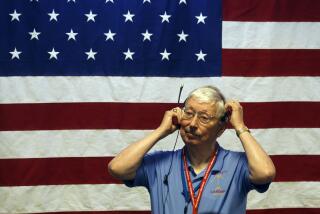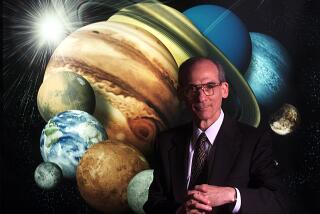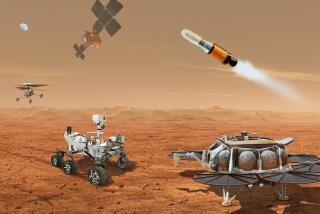Man on a Mission Heads Rover Team
- Share via
Peter C. Theisinger exudes Zen-like calm as he tackles one of the most demanding engineering jobs on Earth — leading NASA’s twin missions to place robotic explorers on Mars.
He’s a rumpled, heavyset man with large, metal-rimmed glasses and a degree in physics from Caltech — a perfect fit in the nerdy informality of NASA’s Jet Propulsion Laboratory in Pasadena.
But his work is anything but casual.
Theisinger, 58, manages about 1,000 Mars lander scientists, engineers and technicians, a job that requires not just technical smarts but well-honed diplomatic skills to referee competing ambitions to squeeze every possible experiment from the probes.
“For an $800-million project, you could have a dictator,” said Joy Crisp, JPL’s chief scientist for the rover project. “He listens to people.”
The stakes of making smart choices are enormous: Success for Spirit and its identical twin, Opportunity (scheduled to land Jan. 24), would dramatically advance our understanding of another world, and could elucidate the origins of life.
Theisinger never sought the pressure or the limelight of the Mars missions. Managing the rovers was simply the next logical step for a modest man who has spent his professional life building interplanetary explorers.
The Fresno native, whose father was an electrical engineer and mother a schoolteacher, describes his ascent as serendipitous — “it happened to me. I had nothing to do with it.”
After graduating with a bachelor’s degree in physics from Caltech in 1967, Theisinger took a summer job at JPL, analyzing transmissions from a probe to Venus. He compared the slow trickle of data to the tap-tap-tap of Morse code, a far cry from the digital images beamed from the rover now on Mars.
But he was hooked by the experience. Except for a stint at a NASA contractor, he has never left JPL’s gravitational field.
Theisinger’s career has taken him — via his beloved robots — to the farthest reaches of the solar system. He got his first taste of Mars with Mariner 9 — a pioneering orbiter that returned thousands of images of the planet’s surface in 1971 and 1972. He later worked on the Voyager mission to the outer planets in 1977.
Theisinger also helped design the power system for Galileo, a successful probe to Jupiter and its moons. He was lead engineer on Mars Global Surveyor, which began orbiting the planet in 1997 and is now relaying data from the Spirit rover.
Given his range of experience and history of success, Theisinger was then tapped for what would be his biggest challenge.
For the last few years, he has lived and breathed the Mars rovers. On his cluttered desk in a corner office at rover headquarters, he kept a digital clock that counted down the days, hours, minutes and seconds to Spirit’s touchdown. Beside it, etched on a paperweight, was a quote from Winston Churchill: “Never never never quit.”
Much of his job has involved matching an experimental wish list against the limits of engineering to carry the experiment safely to a cratered landscape many millions of miles away.
“Pete is one of these guys who can look at a huge engineering problem and cut through to the parts that matter incredibly quickly,” said Steve Squyres, a Cornell University geologist and principal investigator of the Mars rovers. “He has all of the technical and leadership skills that one expects. But he adds to that an appreciation for the science.”
Arizona State University geologist Phil Christensen, who led a team that created an instrument to map the Martian surface based on the heat given off by rocks and soil, put it more bluntly: “Pete knows enough engineering to know when he’s being lied to.”
After the successful landing of Spirit, he described his most important management insight: “Find people who are knowledgeable, smart and committed.”
“Your job is not to direct them, but to remove the things in their way,” he said.
Theisinger said his decades of experience have helped guide the current missions, but cautioned that overconfidence based on hindsight can prove dangerous on the treacherous surface of another planet.
“You understand the problems better, you understand the terrain better,” he said. “On the other hand, [we can now] see risks we didn’t know were there before.”
That makes him wonder what else is lurking on the Martian surface. More than half of the 36 missions to Mars have ended in catastrophe. Most recently, the British Beagle 2 lander has been silent since its scheduled landing nearly two weeks ago.
Having observed the loss of NASA’s Mars Climate Orbiter and Mars Polar Lander in 1999, Theisinger knows the steep cost of failure: months of investigation, fresh doubts in Congress about a troubled space agency, and often, derailed careers.
Theisinger said he’s always mindful that NASA’s work also depends on convincing the average person that space exploration is a crucial national priority.
But to an engineer on the rover project, such concerns must recede to the background when the fate of a mission still hangs in the balance.
At the stroke of midnight Saturday, after a few hours of excitement and revelry by dozens of members of the lander team in JPL’s mission control room, it fell to Theisinger to move the crowd of well-wishers out of the control team’s way.
There was work to be done.






